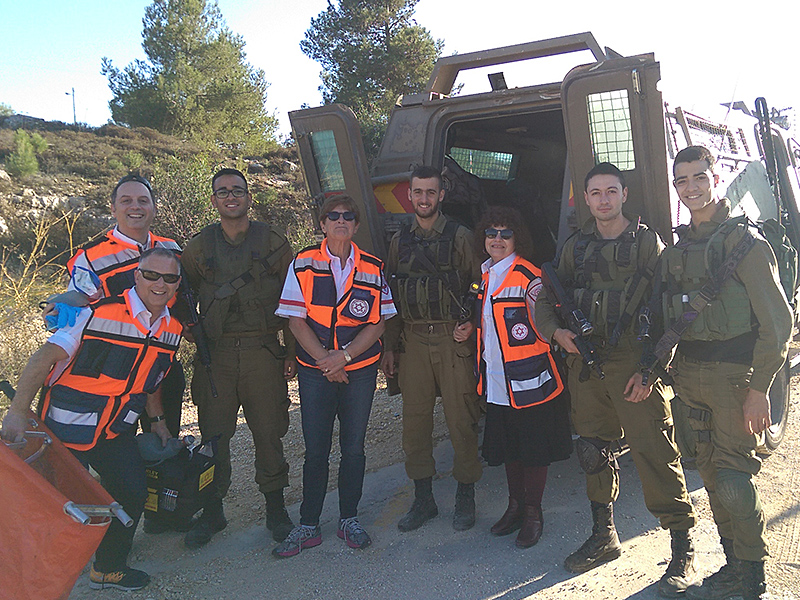“Are you coming with us?” were the initial words my pediatric colleague Dr. Shawna Granovsky asked me last May when inviting me to join the newly launched Magen David Adom (MDA) International Doctors Program.
A staunch supporter of Israel, Granovsky said her dream was to assist the MDA in a way that money could not: with her professional work as a physician, arm in arm with MDA paramedics and emergency medical technicians (EMT), helping Israelis.
READ: Canadian doctors train for possible Israeli disaster
Organized by MDA Canada and directed by Daniel Amzallag, a group of 19 doctors from the Greater Toronto Area, Ottawa, Hamilton and Calgary set out on the first mission of its kind, bringing North American doctors to learn about first responders in Israel. When the trip was launched, there was relative calm in Israel. Sadly, all of us who remained committed to the trip realized that by then, there was yet again another conflict terrorizing our Israeli brethren. Nonetheless, with our families’ blessings, we set off to learn and help in any way possible.
Our backgrounds varied, including pediatrics, family practice, obstetrics/gynecology, anesthesia, psychiatry and emergency medicine. Nineteen physicians came together for one week all with a common goal: to learn how MDA works and how to assist MDA in helping Israelis. Although all seasoned in our respective specialties, we approached this new opportunity as medical students exposed to their first shift in the ER, with both excitement and trepidation.
To assist us in “easing” into Israeli medical culture, MDA hosted our team for the initial Shabbat. There we met Ilan Klein, a senior MDA EMT, who shared with us what life is like for a first responder to emergencies, including terror.
READ: After the terror – Israel’s emergency workers
Forever on call, Ilan answered a “101”call (aka 911) en route to the hotel, while in his Shabbat clothes, as the first call to the scene of a stabbing at gates of the Old City. We could see how every page for help would result in llan suddenly stopping his discussion and, in a split second, deciding if the call was near enough for him to assist. As we would quickly learn, Ilan’s response was ingrained in all MDA personnel.
After Shabbat, our team was given a tour of how the MDA accesses the Old City of Jerusalem, using the “mule,” a modified golf cart, designed to access narrow passageways in each of the four quarters. We were given some precious moments of prayer at the Kotel, the Western Wall, in preparation for our week ahead.
Our team met our EMT instructors, Rephael, 28, Eliezer, 26, and Noa, 22, who instructed us from 8 a.m. to 8 p.m. During the week, our team reviewed protocols in advanced life support, learned how to navigate in the “natan,” or mobile ICU ambulances. Our tours included the MDA call-in headquarters, Hadassah hospital at Mount Scopus, the Knesset and a medical army base in Binyamin, where we were exposed to a mock MCI, mass casualty incident, in co-ordination with army medical personnel.
Throughout our training time, our team learned two most extraordinary facts: that the majority of the labour force in MDA are volunteers, and that the 650-million NIS (about US $167.5-million) budget is not funded by the government. MDA relies on worldwide donations to assist with 25 per cent of its budget.
Our training culminated with a 24-hour period where each of us was assigned to one of three ambulance stations to assist in a shift covering emergencies in Jerusalem. The ER calls covered adult and pediatric emergencies including assisting with a home childbirth. When calls came in for Arab neighbourhoods, police or army would provide security, often to homes where Arabs were quite gracious about our arrival.
In my case, the head EMT, a devout Palestinian Muslim worked side by side and trust in trust with a devout Jewish EMT who hailed from one of the settlements. We all witnessed unique bonds between Jews of all backgrounds and between Jew and Arab.
Painful as it was to hear of stabbing attacks that would pull away our instructors during the middle of the day, we learned that being part of MDA gave us strength to run, strength to help and strength to show our love to Israelis, a strength that we could not attain in Canada.
We physicians were in awe of the professionalism and pride of all of the MDA staffers we encountered, from the volunteers at the call centres to the blood bank and EMT paramedics, who lived their days being both Israeli and members of the Magen David Adom.
Having received our “License to Save” card as MDA’s International Doctors On Call for Israel, I turned to Granovsky at Ben-Gurion Airport and asked, “When are we coming back?”
Dr. Jason Ohayon is a consultant pediatrician-allergist in Hamilton, Ont.
